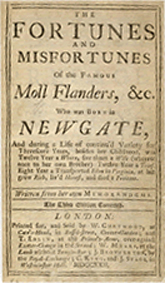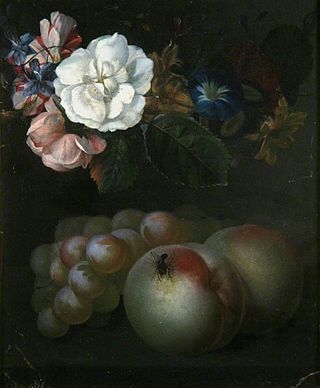This article contains information about the literary events and publications of 1683.

The Scarlet Letter: A Romance is a work of historical fiction by American author Nathaniel Hawthorne, published in 1850. Set in the Puritan Massachusetts Bay Colony during the years 1642 to 1649, the novel tells the story of Hester Prynne, who conceives a daughter with a man to whom she is not married and then struggles to create a new life of repentance and dignity. As punishment, she must wear a scarlet letter 'A'. Containing a number of religious and historic allusions, the book explores themes of legalism, sin and guilt.

Moll Flanders is a novel by Daniel Defoe, first published in 1722. It purports to be the true account of the life of the eponymous Moll, detailing her exploits from birth until old age.

The Elizabethan Religious Settlement is the name given to the religious and political arrangements made for England during the reign of Elizabeth I (1558–1603). The settlement, implemented from 1559 to 1563, marked the end of the English Reformation. It permanently shaped the Church of England's doctrine and liturgy, laying the foundation for the unique identity of Anglicanism.

Louise Renée de Penancoët de Kéroualle, Duchess of Portsmouth was a French mistress of King Charles II of England. She was also made Duchesse d'Aubigny in the peerage of France.

Mary Dyer was an English and colonial American Puritan-turned-Quaker who was hanged in Boston, Massachusetts Bay Colony, for repeatedly defying a Puritan law banning Quakers from the colony. She is one of the four executed Quakers known as the Boston martyrs.

A jeremiad is a long literary work, usually in prose, but sometimes in verse, in which the author bitterly laments the state of society and its morals in a serious tone of sustained invective, and always contains a prophecy of society's imminent downfall.

Delarivier "Delia" Manley was an English author, playwright, and political pamphleteer. Manley is sometimes referred to, with Aphra Behn and Eliza Haywood, as one of "the fair triumvirate of wit", which is a later attribution.
Venus in the Cloister or The Nun in her Smock, known in the original French as Vénus dans le cloître, ou la Religieuse en chemise (1683), is a work of erotic fiction by the Abbé du Prat, which is a pseudonym for an unknown author. Candidates for whom this might be include Jean Barrin and François de Chavigny de La Bretonnière.

Cornelia Sorabji was an Indian lawyer, social reformer and writer. She was the first female graduate from Bombay University, and the first woman to study law at Oxford University. Returning to India after her studies at Oxford, Sorabji became involved in social and advisory work on behalf of the purdahnashins, women who were forbidden to communicate with the outside male world, but she was unable to defend them in court since, as a woman, she did not hold professional standing in the Indian legal system. Hoping to remedy this, Sorabji presented herself for the LLB examination of Bombay University in 1897 and the pleader's examination of Allahabad High Court in 1899. She became the first female advocate in India but would not be recognised as a barrister until the law which barred women from practising was changed in 1923.
Events from the year 1683 in England.

Lucie Skeaping is a British singer, instrumentalist, broadcaster and writer. She was a founder of the early music group the City Waites and the pioneering klezmer band the Burning Bush. She presents BBC Radio 3's Early Music Show, a weekly programme dedicated to the early music repertoire.

The 1668 Bawdy House Riots took place in 17th-century London over several days in March during Easter Week, 1668. They were sparked by Dissenters who resented the King's proclamation against conventicles while turning a blind eye to the equally illegal brothels. Thousands of young men besieged and demolished brothels throughout the East End, assaulting the prostitutes and looting the properties. As the historian Tim Harris describes it:
"The riots broke out on Easter Monday, 23 March 1668, when a group attacked bawdy houses in Poplar. The next day crowds of about 500 pulled down similar establishments in Moorfields, East Smithfield, St Leonard's, Shoreditch, and also St Andrew's, Holborn, the main bawdy house districts of London. The final assaults came on Wednesday, mainly in the Moorfields area, one report claiming there were now 40,000 rioters - surely an exaggeration, but indicating that abnormally large numbers of people were involved. ... On all days the crowds were supposedly armed with 'iron bars, polaxes, long staves, and other weapons', presumably the sort of tools necessary for house demolition. The rioters organized themselves into regiments, headed by a captain, and marching behind colours."
Damaris Page also known as Damarose Page, was a London brothel keeper, entrepreneur and property developer, one of the most successful and famous prostitutes of her time.

Elizabeth Cresswell, also known as Mother Creswell and Madam Cresswell of Clerkenwell, was one of the most successful prostitutes and brothel keepers of the English seventeenth century. Starting with houses in Bartholomew Close, in the City of London and St Leonard's, Shoreditch, she built a widespread network of brothels across London, supplied with girls and women from across England. Her employees included the wives of soldiers pressed into service for Charles II and gentlewomen who had supported the Cavalier cause during the English Civil War and had since fallen on hard times. Her bawdy houses were favoured by King Charles and his court as well as powerful figures in government and city guilds. This position gave her a measure of immunity from prosecution and added to her profile as a caricature of iniquity and corruption.

The Whores' Petition was a satirical letter addressed from brothel owners and prostitutes affected by the Bawdy House Riots of 1668, to Lady Castlemaine, lover of King Charles II of England. It requested that she come to the aid of her "sisters" and pay for the rebuilding of their property and livelihoods. Addressed from madams such as Damaris Page and Elizabeth Cresswell, it sought to mock the perceived extravagance and licentiousness of Castlemaine and the royal court.

The Fair Jilt: or, the Amours of Prince Tarquin and Miranda is a short novella by Aphra Behn published by Will Canning in 1688, a year before Behn's death. The plot is loosely based around rumors Behn had heard regarding a story of Prince Francisco de Tarquini. Though Behn did insist that the story was true, it is sensationalized. The story follows a woman named Miranda who, slighted by the rejection of a priest, accuses him of rape. After Miranda marries Prince Tarquin, the story observes their series of deceptive acts and multiple murder attempts instigated by the passions of love and desire. The Fair Jilt occupies itself with themes of deceit, infatuation, and impassioned acts of love, common ideas within the amatory fiction genre. Behn herself introduces the story as a study of the destructive power of love.

Agatha van der Mijn, was an 18th-century flower painter from the Dutch Republic active in London.

Priss Fotheringham was an English sex worker and madam from London who was described in a number of publications from the 1660s. One publication, The Wandering Whore, described her as the 'second best whore in the city'. An unofficial blue plaque commemorating her was installed in 2012 at the corner of Whitecross Street and Old Street in East London, but was reported in January 2023 to have "recently been obscured by a new artwork". As of 26 July 2023 the artwork had been changed and the unofficial blue plaque moved, so it is visible below the new artwork.














